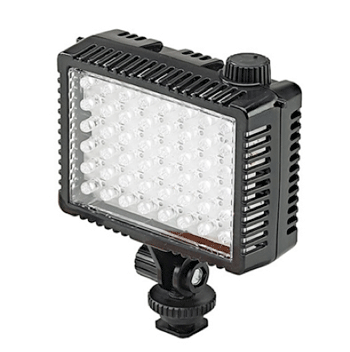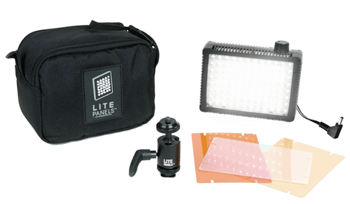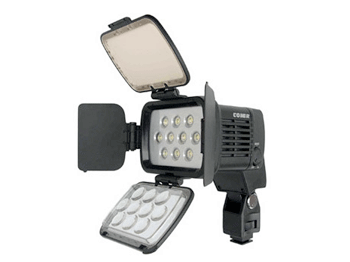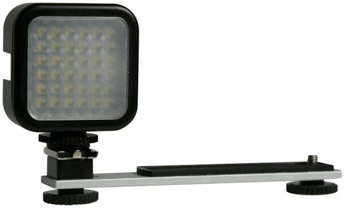The author compares three popular on-camera LED models, plus a much cheaper consumer version, to find out which one goes the distance
When I transitioned to HD, my first camera was a Sony FX1. Definitely not a low-light camera, compared to my Panasonic AG-DVC200. The FX1 was 15 years behind in low-light sensitivity, and needs a lot of light. Unfortunately, the Tri-Lite made the handheld FX1 front heavy. Plus, the light was meant for 4:3 aspect ratios, so there was significant light fall off in very wide shots. Not long after, I was introduced to the Litepanels Micro LED light. At that point, all of the LED lights I’d seen for field use were a joke. I was resistant. The PR people knew this, and one actually dragged me into the Litepanels trade show booth to show me the prototype for the Litepanels Micro. Good thing she did: When she turned on the light, I could see the booth model fully lit at 15 ft. I was then informed the dimmable light (of 48 LEDs) would run at full blast for 75 minutes with 4 AA batteries. I looked forward to trying it in the field.
To get a more comprehensive understanding of LED lights, I decided to try out, alternately, four lights at once: The Litepanels Micro (48 LEDs), the newer Litepanels MicroPro (96 LEDs), the Comer 1800 (10 LEDs) and a less bright but also bargain-priced consumer model, the Sima SL-30 (25 LEDs).
Litepanels Micro (MSRP $305, B&H $275)

I like the Litepanels Micro for a number of reasons. First, it weighs only 9 ounces and gives off great illumination at full blast to 15 feet. It is my preferred interview light for a creating an ambient setting. I easily made a 4-pin XLR cord to power it off my regular battery belts and now my Cool-Lux L-20 belts will run the Litepanels (Micro and MicroPro) for a full 24 hours. Second, I love the fact I can use AA batteries. For evening run-and-gun work, I keep always keep four extra AA batteries in a rubber-band in case I need to do a quick change. If I run out, they are easily found at a nearby CVS. Third, the light’s dimmer is smooth and easy to turn.
The down side of the Litepanels Micro is its reach: beyond 15 feet, you are going to need something much more powerful. Forget about hitting a podium from the back of the room with this light. My Tri-lite, on the other hand, can hit from over 50 feet when using the spot. The Litepanels Micro just isn’t made for that kind of shooting. Some colleagues have complained about the construction of the Litepanels Micro, saying it felt cheap and plasticy. I don’t have a problem with its construction. I’ve banged and dropped the light several times, and it still goes strong. The worst that happened was the flip down filter holder sometimes popped off if when I dropped it. But it’s made of flexible, not brittle plastic, so it won’t break when dropped and takes two seconds to reattach.
Summary: The Litepanels Micro my favorite travel light. It is lightweight, great for interviews, and can be powered be readily available AA batteries.
Litepanels MicroPro (MSRP $450, B&H $405)

The Litepanels MicroPro is the big brother to the Micro. There are many differences in the lights besides the 48 vs. 96 LEDs. The MicroPro is alao a great interview light. The doubled number of LEDs and the use of six AA batteries give you the option of more power vs. run time. Although the MicroPro is quite a bit bulkier than the Micro, it still only weighs a few ounces more than the smaller version. I use this light doing interviews on the Sony HVR-S270u, Sony’s HDV camcorder.
But there were a number of things I didn’t like about the MicroPro. As mentioned before, the filter holder on the Micro is easy to flip up and down when you need it. The MicroPro stores the filters on the back of the light, which covers the battery compartment and the DC power input. This means you must remove the filter to change the AAs, then put the filter back. A few times I was in a rush and forgot where I put the filters. When I use the light on the Sony s270, I like to use it with a belt. The filters and diffusers stored in back block the DC in, meaning you need to leave the filters and diffusers in your camera bag. The socket for the DC in socket also frequently comes out with the power cable. It is easy to pop back in, but you must remove the cable very carefully. Pulling it to hard and quick may not only pull out the socket, it could also rip out the wires that attach it to the rest of the light.
I’m also not a fan of the base of the light that slips into the cameras accessory shoe is a bit over complicated. On the Micro, there is a knob to loosen a joint that lets you adjust the angle of the light; it works very well. The MicroPro has an articulated ball joint that is very difficult to adjust on the fly. Turning the small handle on the joint not only loosens the tilt, but every other direction as well. This meant that frequently, the light was spinning or flopping out of control. I’m guessing the handle was designed with specific cameras in mind. But for my purposes, the handle was awkwardly placed. If you have a notch in the mount that lets you tilt the light forward facing forward, the light fixture itself blocks the user from loosening it.
Summary: The Litepanels MicroPro gives out more light than the Micro, but its ergonomics, ease of use, and overall engineering fall short compared to its baby brother. I’ve already voiced my concerns to Ken Fisher, the president of Litepanels, and he told me the company has already resolved the power jack and the pivoting base issues.
Comer CM-LBPS1800 MSRP $399

The Comer CM-LBPS1800 light was brought to my attention by one of my cameramen who insisted I try it while we were working together. I swapped the 96-LED Litepanels MicroPro for the 10 LED CM-LBPS1800 and was blown away. I couldn’t believe that it almost has the throw of my incandescent Cool-Lux Tri-Lite.
Somehow, with almost 10x less LEDs, it was far brighter than the Litepanels MicroPro. The dimmer is on the side of the light and is easier to adjust than the Litepanels lights, which have it on top. For further adjustments there are barndoors on the left and right of the LEDs, a 3200K filter that is hinged to the bottom, and a spotlight lens that focuses all of the LEDs into a tighter, more intense pattern.
There are two options for powering the Comer. The first is with Sony “L” series camcorder batteries, the same ones used for Sony’s PD150, Z1, Z7, FX1 camcorders. Chances are you have a compatible battery around. If not, purchasing the Sony NP-F970 batteries are an inexpensive way to keep the light going for hours. The cameraman who recommended the light to me said he has used it in low-light situations all night and never used up the battery. There is also a DC 7-18 volt power receptacle on the light. As a bonus, the light comes with two different-length cables for Anton Bauer power taps, plus a very nice carrying case.
I had only one issue with the Comer light: When I used Lenmar LIS-750 and 950 Sony-compatible batteries, the CM-LBPS1800 would start pulsing on and off when the battery dropped below a certain power level. Reps from Comer told me the light was only certified with Sony, Anton-Bauer Power tap and its own batteries. I tried the Anton-Bauer power tap on a Trimpack 14 NiCd battery and after a few hours, it drained it without pulsing. My friend uses the Lenmar batteries without issues on his LED1800. Not sure what is going on, but when I stick to the certified batteries it seems to work without issue.
Aside from that curiosity, I really did not find anything else to complain about on the Comer CM-LBPS1800. It has the same form factor as the Cool-Lux Tri-Lite, though maybe it’s a little bigger with the battery attached. It works great on the Sony s270. It makes handheld camcorders, like my Sony FX1, a bit front heavy, but my cameraman who uses it with a Sony Z7u (similar form factor to the FX1), has no problem with it.
Summary: The Comer CM-LBPS1800 is probably the best all-around LED light I have come across and works well for both interviews and on larger, longer-throw shoots.
Sima SL-20LX (MSRP $79.99 ‘ B&H $29.99)

The Sima SL-20LX is a consumer 36-LED light that is also finding its way into the hands of professionals. It was brought to my attention by a colleague that uses it as a backup to his Comer LED1800. It is a lot brighter than any consumer light I have seen yet. It has some pretty unique features also. It has three built-in accessory shoes to attach additional SL-20s or other accessories like microphones. My colleague attaches three of the SL-20LXs together for pro work with his Sony Z7u. He can turn them on and off to change the brightness.
Using this light to its fullest means knowing its limitations. The light will run about 50 minutes on its internal, non-removable, battery pack. It also takes about three hours to fully charge and has an on/off switch but no dimmer. The switch moves fairly easily, so be careful. More than once I pulled it out of my camera bag to find that just the normal bouncing around during transport had turned it on and drained the battery. The batteries will give out after a few years or so, at which point you either trash the light or open it up and re-cell it. (Can’t be that hard, even though Sima wouldn’t want you to do it.) As of this writing Sima is introducing the SL-20LXI model, which runs off of battery AC. Since the AC is being converted to DC, there is probably a good chance you can make a cable to run it off an Anton Bauer power tap, or 4-pin XLR and a belt. This is a much cheaper light, so you won’t get the additional 3200K filter as you do with the other lights. You’ll need to white balance accordingly or make your own filter by getting the proper gel from a photography shop.
Summary: Despite these limitations, the SL-20LX makes a great, inexpensive backup light for any professional. At this price, even a 50-minute run time could save a shoot.
Which One Is Best? It Depends
If I have to pick a best all-around LED light of the four above, it would be the Comer CM-LBPS1800. This light does a lot with only 10 LEDs, has a far throw, has many power options, has filters and the spotlight lens built-in, and can get through an entire job with only one NP-F970 Sony L series battery. It also works great on both full- and mid-size camcorders.
For smaller camcorders where weight is an issue or you don’t need the throw of the Comer, the Litepanels Micro is great. For a tight interview the Micro will easily do the job.
The MicroPro, in my humble opinion, needs a bit of a redesign before it becomes as truly useful as the original Micro.
While I may be hesitant to use the Sima SL-20LX as a main light (other than for home videos), it makes a great backup light for pros. For under $40, everyone should have one or two of these-or the upcoming SL-20LXI model-in their main camera kit.
As of this writing the Litepanels SolaENG light, which was introduced at this year’s NAB show in Las Vegas, shows a lot of promise but wasn’t ready for this comparison. It will feature four giant LEDs instead of many small ones. I can’t wait to try it out against the Comer CM-LBPS1800.










